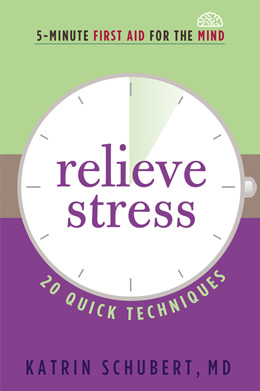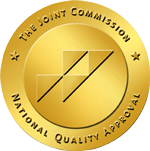
"Can you imagine the mental and physical energy it requires to keep those muscles tightened?"

Other titles you may like.

Reduce Craving: 20 Quick Techniques

Almost Anxious:
Is My (or My Loved One's) Worry or Distress a Problem?

Almost Alcoholic:
Is My (or My Loved One's) Drinking a Problem?
Visit Recovery Road to view and
listen to all the episodes.
Episode 201 -- March 17, 2022
Just Breathe: Two Techniques to Help You Relax
Stress is part of everyone's life. Those of us new to recovery have let go of the substances and processes we once relied on to detach from our anxiety and calm our feelings of fear. Now we need some new—and hopefully healthier—ways to manage daily stress.
Relieve Stress: 20 quick Techniques, by Dr. Katrin Schubert, is an accessible guide to coping with stressful situations in recovery and daily life. In the book, Schubert shares easy and quick exercises that promote in-the-moment body awareness and emotional mindfulness.
The following excerpt includes two of Schubert's step-by-step breathing techniques. The first focuses on the soothing joy that comes with gratitude for each organ in our bodies. The second helps us relax by letting go of tension with every exhalation.
This excerpt has been edited for brevity.
TECHNIQUE 16
The Tibetan Smile
GRATITUDE IS THE MOTHER OF
SPIRITUAL GROWTH
Phil had not been feeling well. His doctors had given him bad news: he was very ill. His mind was churning, and he felt his muscles tighten with fearful anticipation of his treatment plan. His sympathetic nervous system, which triggers the fight-or-flight response, was in overdrive. Phil knew that only a relaxed body can recover from illness, and he remembered the Tibetan Smile meditation that he had experienced once some time ago. Practicing it daily helped him deal with the stress caused by his illness and contributed to a faster recuperation.
Gratitude reconnects us with the positive aspects of our lives. It fosters spiritual growth and gets us out of the trenches of self-pity. Gratitude has been promoted by therapists and spiritual leaders as a healing exercise that connects the mind and spirit. We are usually asked to give thanks to things outside of ourselves, such as our family and friends, shelter and food, or our general safety and well-being.
A beautiful Tibetan prayer asks us to go inward and gratefully acknowledge individual parts of our body-mind. This can boost our immune system, enhance blood supply to the areas we focus on, calm us, and lift our spirits. It can have tremendous health benefits when practiced regularly.
HOW TO DO IT
Get comfortable wherever you are. Take a deep and gentle in-breath, nourishing your body with oxygen. Now gently let go of your breath.
This technique helps you to focus on individual body parts, gratefully acknowledging them when you inhale and sending them a smile of healing when you exhale.
Here is an example:
Breathing in I give thanks to my eyes, breathing out I smile at my eyes.
Breathing in I give thanks to my ears, breathing out I smile at my ears.
Breathing in I give thanks to my heart, breathing out I smile at my heart.
Breathing in I give thanks to my brain, breathing out I smile at my brain.
Breathing in I give thanks to my liver, breathing out I smile at my liver.
Breathing in I give thanks to my feet, breathing out I smile at my feet.
While reciting this prayer you may choose to follow a pattern, for example from head to toe, or you may choose to spontaneously follow your inspiration and guide yourself to the organs that come to your awareness. Include the parts of your body that are not entirely healthy at this time. There is no right or wrong way to do this exercise.
TECHNIQUE 17
Exhale
Darius, a twenty-something IT specialist employed by a municipality, was very stressed. His mind was unable to focus, and he felt a heavy weight on his chest. He used to love his job, back when he had a great boss and their working arrangement was built on trust. He now had a different boss who made new rules that restricted him. She tightly controlled his work activity and whereabouts. Darius had lost interest in his work, and his mind was constantly rehashing their unpleasant interactions. Feeling like an orbiting ball of nerves, he had a hard time completing his tasks.
Darius tried the following relaxation exercise, and it helped him settle his mind and relax his body so he could deal more objectively with his new boss.
This is a very easy exercise. As with all the other mind-mending techniques, you can do it anywhere and at any time (provided you are not driving a car or operating any heavy machinery, of course!).
HOW TO DO IT
Begin with a mental body scan. Starting with your head and face, notice any tension in the muscles without attaching any judgment to it. Continue doing the same thing as you move down to your neck, arms, chest, abdomen, hips, upper legs, and lower legs, then finally your ankles, feet, and toes. Allow your breath to gently flow in and out of your body as you go. Now, following the same path you took with your mental body scan, focus on your breathing, paying particular attention to every out-breath. As you gently exhale, let go of muscle tension in each area.
Here is an example:
Inhale, then exhale and let go of tension on top of your head;
inhale, then exhale and let go of tension in your jaw;
inhale, then exhale and let go of tension around your eyes;
and so on.
Keep relaxing every muscle group in your body you can think of, noticing the difference in each area of your body as you release the tension.
Can you imagine the mental and physical energy it required to keep those muscles tightened?
About the Author:
Katrin Schubert has dedicated her career to helping her fellow human beings heal their bodies, minds, and spirits with natural medicine. After completing her medical degree and a PhD in human genetics at the University of Hamburg, and receiving international training in England, the Czech Republic, India, China, Canada, and the United States, she opened her holistic health clinics in Kingston and Gananoque, Ontario, Canada. Katrin also has a science degree from Queen's University in Kingston. You can contact Katrin through social media.
© 2016 by Katrin Schubert
All rights reserved

